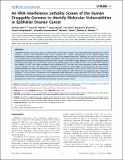| dc.contributor.author | Sethi, Geetika | |
| dc.contributor.author | Pathak, Harsh B. | |
| dc.contributor.author | Zhang, Hong | |
| dc.contributor.author | Zhou, Yan | |
| dc.contributor.author | Einarson, Margret B. | |
| dc.contributor.author | Vathipadiekal, Vinod | |
| dc.contributor.author | Gunewardena, Sumedha | |
| dc.contributor.author | Birrer, Michael James | |
| dc.contributor.author | Godwin, Andrew K. | |
| dc.date.accessioned | 2013-04-10T14:51:17Z | |
| dc.date.issued | 2012 | |
| dc.identifier.citation | Sethi, Geetika, Harsh B. Pathak, Hong Zhang, Yan Zhou, Margret B. Einarson, Vinod Vathipadiekal, Sumedha Gunewardena, Michael J. Birrer, and Andrew K. Godwin. 2012. An RNA interference lethality screen of the human druggable genome to identify molecular vulnerabilities in epithelial ovarian cancer. PLoS ONE 7(10): e47086. | en_US |
| dc.identifier.issn | 1932-6203 | en_US |
| dc.identifier.uri | http://nrs.harvard.edu/urn-3:HUL.InstRepos:10522853 | |
| dc.description.abstract | Targeted therapies have been used to combat many tumor types; however, few have effectively improved the overall survival in women with epithelial ovarian cancer, begging for a better understanding of this deadly disease and identification of essential drivers of tumorigenesis that can be targeted effectively. Therefore, we used a loss-of-function screening approach to help identify molecular vulnerabilities that may represent key points of therapeutic intervention. We employed an unbiased high-throughput lethality screen using a 24,088 siRNA library targeting over 6,000 druggable genes and studied their effects on growth and/or survival of epithelial ovarian cancer (EOC) cell lines. The top 300 “hits” affecting the viability of A1847 cells were rescreened across additional EOC cell lines and non-tumorigenic, human immortalized ovarian epithelial cell lines. Fifty-three gene candidates were found to exhibit effects in all tumorigenic cell lines tested. Extensive validation of these hits refined the list to four high quality candidates (HSPA5, NDC80, NUF2, and PTN). Mechanistic studies show that silencing of three genes leads to increased apoptosis, while HSPA5 silencing appears to alter cell growth through G1 cell cycle arrest. Furthermore, two independent gene expression studies show that NDC80, NUF2 and PTN were significantly aberrantly overexpressed in serous adenocarcinomas. Overall, our functional genomics results integrated with the genomics data provide an important unbiased avenue towards the identification of prospective therapeutic targets for drug discovery, which is an urgent and unmet clinical need for ovarian cancer. | en_US |
| dc.language.iso | en_US | en_US |
| dc.publisher | Public Library of Science | en_US |
| dc.relation.isversionof | doi:10.1371/journal.pone.0047086 | en_US |
| dc.relation.hasversion | http://www.ncbi.nlm.nih.gov/pmc/articles/PMC3467214/pdf/ | en_US |
| dash.license | LAA | |
| dc.subject | Biology | en_US |
| dc.subject | Biochemistry | en_US |
| dc.subject | Drug Discovery | en_US |
| dc.subject | Genetics | en_US |
| dc.subject | Gene Expression | en_US |
| dc.subject | RNA interference | en_US |
| dc.subject | Cancer Genetics | en_US |
| dc.subject | Genomics | en_US |
| dc.subject | Functional Genomics | en_US |
| dc.subject | Molecular Cell Biology | en_US |
| dc.subject | Cellular Types | en_US |
| dc.subject | Epithelial Cells | en_US |
| dc.subject | Cell Growth | en_US |
| dc.subject | Medicine | en_US |
| dc.subject | Oncology | en_US |
| dc.subject | Cancers and Neoplasms | en_US |
| dc.subject | Gynecological Tumors | en_US |
| dc.subject | Ovarian Cancer | en_US |
| dc.subject | Basic Cancer Research | en_US |
| dc.title | An RNA Interference Lethality Screen of the Human Druggable Genome to Identify Molecular Vulnerabilities in Epithelial Ovarian Cancer | en_US |
| dc.type | Journal Article | en_US |
| dc.description.version | Version of Record | en_US |
| dc.relation.journal | PLoS ONE | en_US |
| dash.depositing.author | Birrer, Michael James | |
| dc.date.available | 2013-04-10T14:51:17Z | |
| dc.identifier.doi | 10.1371/journal.pone.0047086 | * |
| dash.contributor.affiliated | Vathipadiekal, Vinod | |
| dash.contributor.affiliated | Birrer, Michael J. | |


